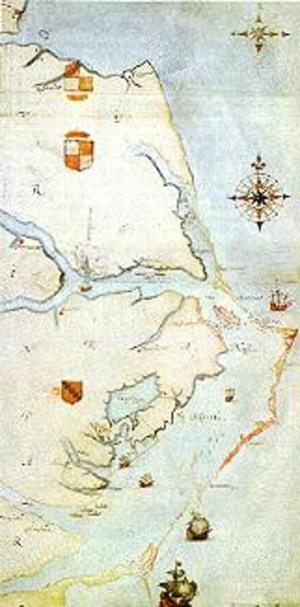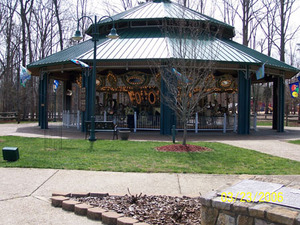The story of the Lost Colony of Roanoke is a great American mystery, one that endures to this day. Mentioning the word ‘Roanoke’ prompts a wide array of speculation, opinions, and, as to be expected, ghost stories.
Before the settlement of famous Jamestown and tales of a native named Squanto helping the Pilgrims, before the alleged affair of Captain John Smith and the Indian maiden Pocahontas on the eastern shores of the New World, a tiny colony sprouted in fertile soil. It began with grand hopes and dreams, but ended in tragedy on those very same shores.
Recently, a group of archaeologists and historians met in North Carolina to raise money for new excavations in Fort Raleigh Park in an effort to finally discover what happened to the people who settled on the isolated island off the coast of Virginia in the 1580’s. Is the story truly a ghost story or a tale of a grand experiment gone wrong?
It was a time of uncertainty and fear, when people believed the world was flat and horrible sea creatures waited in the depths of the ocean to gobble up brave explorers who dared to venture into their world. It was a time when men and women fought for survival and relied on their own wits, experience and beliefs.
It was a time when the New World was unexplored territory; a place where savages dwelt and wild creatures roamed great, lush forests. It was also a time when Europeans wanted to find new places to live and pursue their own lives, those who sought adventure and thrills perhaps, while others merely sought freedom from the strict rules of European customs and demands.
In the latter 1500’s, explorers became very interested in the New World, and men headed across the ocean to explore her eastern coast. Sir Walter Raleigh was in the good graces of Queen Elizabeth the First of England at the time, and England and Spain were in fierce competition against each other to gain control over this new territory. Queen Elizabeth gave Raleigh funds to supply ships for the purpose of founding a colony in the New World before the Spaniards did. Raleigh had heard reports that the coast of the New World was filled with forests, water, game and fish. He sent his cousin, Sir Richard Grenville ahead of him to to a place called Virginia.
The men and their ships arrived on Roanoke Island in 1585 and began to build a settlement t they called ‘Fort Raleigh. That August, Grenville returned to England for more supplies, leaving Ralph Lane in charge as Governor of the island. Grenville left 107 men with Lane on the island to ensure their claim on the continent before Spain could.
While Grenville was away, Lane and his men continued construction on their settlement and explored their island and its surrounding areas. Unfortunately, Lane wasn’t very polite to the natives who inhabited the area and treated them rather badly. Lane and his men even went so far as to raid nearby Indian villages. They killed one of the native chiefs. Bad mistake.
Another explorer, Sir Francis Drake, arrived at the island in the early summer of 1856 to find the Roanoke settlers low on food and in constant danger from agitated natives. Fearing attacks and deciding he and the others wouldn’t make it through the coming winter months, Governor Lane and his men decided to abandon the island and return to England with Sir Drake.
Meanwhile, Sir Grenville returned to the island with three shiploads of supplies, only to find the island deserted. One can imagine his frustration! He also made the decision to return to England, but left fifteen of his men on the island to ensure the colony’s claim on the land.
Back in England, Sir Raleigh gathered another group of people to take back to Roanoke, and found ninety-one men, seventeen women and nine children to populate his colony at Roanoke. He named JohnWhite to be their new governor.
This second group arrived on the island in July 1587 with the intention of stopping by to pick up the handful of men left by Sir Grenville, but after their landing boats touched shore, they found only the remnants of a human skeleton. Though they searched the island for the others, the small group of men who had been left behind was nowhere to be found.
Friendly Croatoan Indians lived on an island to the south of Roanoke. They taught the newcomers how to hunt and fish. One of the settlers, a woman named Eleanor Dare, was expecting a baby, and the first English child born in America arrived in August of 1587. She was named Virginia Dare. Though the settlers had supplies and plenty of fish and game, winter and hurricanes would soon test their mettle. Again running low on supplies, Governor John White decided to sail back to England for additional provisions, but luck was against him. Upon his arrival in England, he discovered that his country was about to go to war with Spain, and the Queen said she needed every single available ship engaged in service to the war effort.
Governor White’s return to Roanoke was delayed for 3 years, until 1590! Upon his delayed return, Governor White anchored his ships off the outer banks of what is now North Carolina in rough waters known as the ‘Graveyard of the Atlantic. As before, the settlers he had left behind were not to be found, though the letters ‘CRO’ were found carved on a tree near the tiny settlement. On another part of the island, the word ‘CROATOAN’ was discovered carved into a wooden fence post
Theories and unanswered questions about what happened to the missing colony have kept generations of Americans intrigued for decades. Some people believe that local Indians, angered by their treatment at the hands of Governor Lane, killed the men and took the women and children for adoption into their tribe, as was the custom of many Eastern Woodland Indians. Others believe that the settlers merely moved to a different location, but would it’s doubtful they would have done without leaving some word as to where they were. Still others believe that the Spanish had something to do with their disappearance.
In 1607, England sent more colonists to the New World, but this time, they landed further north along the coast of Virginia at a place they named Jamestown. It was there that England managed to plant a firm hold on the New World.
Since 1587, few clues have been unearthed regarding the disappearance of the settlers at Roanoke. As early as 1653, traders and curiosity seekers visited Roanoke Island and walked away with artifacts that, if nothing else, proved that a colony had indeed existed there. During the Civil War, soldiers stationed there also dug for artifacts, and in 1895 a journalist and amateur archaeologist completed some excavations, though the actual site of the village has eluded everyone.
In 1982, the remains of an old well thought to date back to the 16th century was discovered in Roanoke Sound on the northern end of the island. Serious erosion has occurred there for years. In 2000, National Park Service archaeologists using ground-penetrating radar discovered objects buried beneath the sand. In 2002, a swimmer happened to step on an axe head that dated back to the 16th century – in shallow water just off the northern end of the island.
It seems as if perhaps the mystery of the missing colonists of Roanoke Island will continue to remain a mystery, a mystery that Americans delight in trying to solve. Perhaps some things are meant to remain a secret, and the Lost Colony of Roanoke is indeed one of them.




